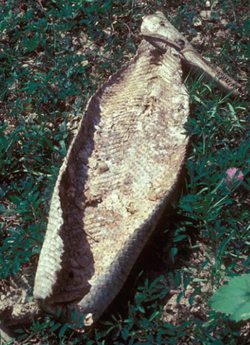Introduction to Delta Pieces: Northeast Louisiana Folklife
Map: Cultural Micro-Regions of the Delta, Northeast Louisiana

The Louisiana Delta: Land of Rivers








Ethnic Groups










Working in the Delta








Homemaking in the Delta




Worshiping in the Delta



Making Music in the Delta




Playing in the Delta







Telling Stories in the Delta



Delta Archival Materials
Bibliography


Gigging
By Hiram Ford "Pete" Gregory, III
Editor's Note: In the early 1990s, Pete Gregory wrote these personal reflections about Northeast Louisiana's Delta and they are published with minimal editing. Also see his Musings on the Louisiana Delta from a Native Son.
One of the tools associated with the back swamps of the Delta was the "gig" or the harpoon. Gigs came in a variety of forms and were classified as those used for fish and those used for bullfrogs. Older harpoons were made from the "neck" on long-handled or "goose-neck" hoes. Local blacksmiths forged a point with a barb, or as local folks put it, a "beard." Some of these were toggle barbs which folded shut as the projectile entered its target and pulled open as the fish struggled to free itself.
Frog gigs were usually three-tined or four-tined like a fork, with vicious stationary barbs. Unlike the fishing harpoons, frog gigs were "store-bought." The gig pole for the fishing gig was tied to the point, but bounced free on impact. The fish then had to pull against the floating pole, some five to six feet in length.
Gigs were used in sloughs or backwater situations especially for taking buffalo fish, carp or gar. The gigger would wade into the water or stand in his boat and wait for the fish to swim past. Once the fish's head was behind the harpooner, he'd turn and throw so the fish would not be frightened or warned by the motion. Some waders threw with an underhand technique. Both techniques were very effective. One gigger remembered harpooning over 100 buffalo fish one spring. The giggers watched for "bubblers," bubbles made by schools of buffalo fish. At times when the fish move into the backswamp to spawn, the water will look like froth and one can track the fish by the bubbles.
Some of the buffalo weighed up to 20 to 30 pounds; and alligator garfish might be five to six feet in length and weigh at least 20 pounds. The harpooner might find he had his work cut out for him. Getting the harpoon set was only part of the task: retrieving the fish could be a really tough job. Buffalo scales big enough to "cover a silver dollar" were sometimes nailed to bar or shed doors to assuage non-believers.
The Casse-burgo (shell breaker), later corrupted to gaspergou, is the freshwater drum fish. The otoliths, calcareous concretions in the inner ear of the "gou fish," were carried for good luck. These "gou rocks" are formed in the fish's head and have a seven-shaped groove, hence their association with good luck.
Garfish are harder to find, but as the sloughs drain and dry in the late summer/early autumn, they can be taken very easily in shallows. Small fish like bass, sac-au-lait or white perch, and bream take refuge in alligator den holes or other deep spots. The gar will often die when the shallows dry up, so harpooning in the flood times was the efficient way to fish for gar. The Indians used large gar scales as arrow-points, as did little boys in the Delta later on. Indian antler harpoons with stationary barbs were frequent finds on Delta Indian sites. Their iron counterparts were likely used the same way.
Gigging is outlawed today. It was too efficient a way to fish. Frogs are taken with spring-operated "garbs," a more efficient tool, and fewer are lost and wasted. Louisiana now sets a legal season for taking frogs. The frog gigs are still sold in hardware stores, but are not legal.
As drainage and levee projects limit the extent of backwater swamps, the habitat changes; and even before gigging was declared illegal, the harpoons were most often left hanging in the cobwebs of barns and sheds across the Delta. Few have been preserved.




